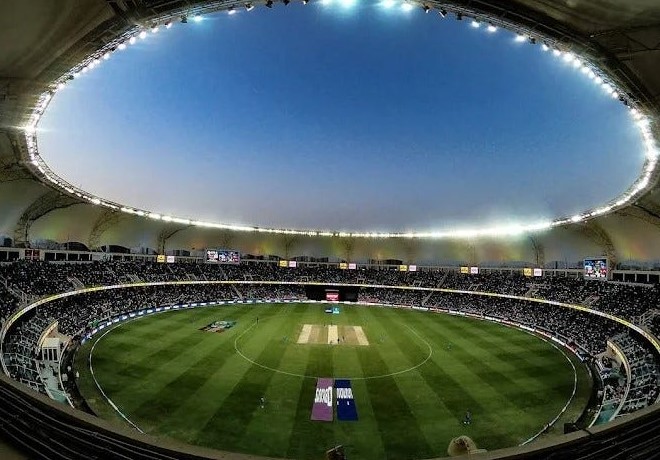E2BET: Dubai International: The Dubai International Cricket Stadium, also known as the Dubai Sports City Cricket Stadium, is one of the premier venues in the world of cricket. Known for its cutting-edge lighting system, world-class facilities, and neutral pitch behavior, this stadium has been host to numerous international fixtures, Indian Premier League (IPL) matches, and ICC tournaments.
One of the most discussed aspects of any cricket ground is its boundary length. This affects batting strategies, bowler tactics, and overall scoring patterns. In this article, we explore the detailed boundary dimensions of the Dubai International Cricket Stadium, supported by tables and technical context.
Overview of the Stadium
| Feature | Details |
|---|---|
| Stadium Name | Dubai International Cricket Stadium |
| Location | Dubai Sports City, Dubai, UAE |
| Seating Capacity | Approx. 25,000 (expandable to 30,000) |
| Inaugurated | 2009 |
| Lighting System | Ring of Fire (No visible floodlights) |
| Pitch Type | Balanced (slightly batting-friendly) |
| Owner/Operator | Dubai Sports City |
Boundary Length – A Detailed Look
Unlike grounds with fixed and uniformly shaped boundaries, the Dubai International Stadium is oval in shape, meaning boundary lengths vary depending on the direction (straight, square, or behind the wicket). Below is a breakdown of typical boundary dimensions under standard international match setups.
1. Standard Boundary Dimensions
| Direction | Approximate Boundary Length (Meters) |
|---|---|
| Straight | 78 – 82 meters |
| Long-On/Long-Off | 75 – 80 meters |
| Square Boundaries | 64 – 68 meters |
| Third Man/Fine Leg | 60 – 65 meters |
| Deep Mid-Wicket | 70 – 75 meters |
| Deep Cover | 70 – 74 meters |
⚠️ Note: Boundary distances may vary depending on match type (T20, ODI, Test) and regulations set by the ICC or tournament organizers.
Comparison With Other Grounds
| Stadium | Straight (m) | Square (m) | Total Size (approx) |
|---|---|---|---|
| Dubai International Stadium | 78 – 82 | 64 – 68 | Large |
| Sharjah Cricket Stadium | 62 – 70 | 58 – 65 | Small |
| Sheikh Zayed (Abu Dhabi) | 74 – 80 | 66 – 70 | Medium-Large |
| MCG (Australia) | 84 – 90 | 80 – 85 | Very Large |
| Eden Gardens (India) | 75 – 78 | 65 – 68 | Medium |
Impact on Match Dynamics
1. Batting Strategies
- Hitting Straight is Rewarding: The longer straight boundaries mean only well-timed lofted shots result in sixes.
- Use of Gaps: Batters focus more on placement and running between the wickets due to longer fence distances in some areas.
- Shorter Square: Offers some relief, especially in T20s, with batsmen targeting square boundaries.
2. Bowling Tactics
- Pace Bowlers: Utilize wider angles to induce mishits to long boundaries.
- Spinners: Prefer bowling wide outside off, daring batsmen to clear long straight fences.
3. Fielding Positioning
- Captains often station boundary riders more strategically, with a preference for patrolling long-on and deep mid-wicket.
Unique Features of Dubai Stadium’s Design
Ring of Fire Lighting
Flexible Boundary Setup
The stadium’s movable boundary rope system allows for adjustment based on match requirements. For example:
- T20 matches may see boundaries brought in slightly (especially square).
- Test matches often use the full field to challenge batsmen.
Boundary Trends in Major Tournaments
IPL Matches
In the 2020 IPL held in UAE:
- Average boundary length (straight): ~78 meters
- Six-hitting zones: Mostly toward deep mid-wicket and long-off
- Bowler advantage: Bigger outfield helped restrict sixes
T20 World Cup 2021
- Shortest boundary: ~63 meters (fine leg area)
- Longest boundary: ~82 meters (straight)
- Winning Strategy: Rotate strike, target square leg and cover areas
Conclusion
The Dubai International Cricket Stadium is not just an architectural marvel; it is a dynamic sporting venue where the boundary lengths significantly influence match outcomes. Its large and variable boundary dimensions demand a higher level of skill from batters and provide bowlers with tactical leverage.
Whether it’s a blistering T20 clash or a high-stakes international ODI, understanding the boundary geometry is key to cracking the Dubai code.


